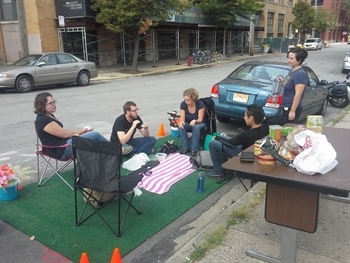
Turning our perceptions of parking space upside down with International Park(ing) Day
 By Marisa Novara and MPC Research Assistant Jason Brown
By Marisa Novara and MPC Research Assistant Jason Brown - October 11, 2013
For the past few years, Metropolitan Planning Council (MPC) has been covering the evolving phenomenon of Park(ing) Day, the third Friday in September that is now celebrated globally as a day to take back the streets by temporarily claiming parking spaces as people places. Park(ing) Day is not only a fun opportunity to play with urban space in a different way, but also a challenge for cities to think about their design on a human scale, to move away from car-oriented planning policies and to highlight local cultural and commercial assets.
It’s great to see that MPC is not alone in championing these values. In the past few years, Park(ing) Day has provided the platform to prove that these ideas are global phenomena. As you can imagine, there are many ways to approach public space development, but there are some specific examples from around the world that encourage us to activate by advocating, collaborating and even competing to create better places for our region’s residents. For the finale of this series, MPC will examine how Park(ing) Day is celebrated in Chicago.
Activate: Chicago
This year in Chicago, a small (but strong!) contingent took their ideas to the streets: Architecture for Humanity Chicago (AFHC) and the Urban Planning and Policy Student Association (UPPSA) at the University of Illinois at Chicago. While both groups are Park(ing) Day veterans, each has a unique vision for what the event means, which mirrors how Chicago is approaching Placemaking as a whole.

Architecture for Humanity (Chicago) face their competition for a park(ing) space.
The architects and designers involved in Chicago’s chapter of Architecture for Humanity sourced recycled goods as usual, which kept financial and energy costs low, and development people-minded. They scaled it down to focus on neighborhood artists and individual art pieces, specifically stools. As pictured to the right, AFHC volunteers fabricated a park-ful of concrete stools using materials donated by Archeworks and wood legs sourced from alleys to fill their space sponsored by Cole’s bar at 2338 N. Milwaukee Ave.

From concrete to color!
Bryn Namavari
AFHC then invited artists from around Logan Square—and all passersby—to come decorate and donate their work. By 8 p.m., all the stools had been decorated and 80 percent of them were donated back to AFHC to be auctioned off at this year’s Fall's Fundraiser in October. And just for fun, each stool comes with a unique QR code so its owner can let AFHC know how far (or close) the stool has wandered from where it was made.

Students and community members gathered around chalk, food, and chatter about public space.
The students in UPPSA were thinking local too, focusing on their campus community and environs. With a simple installation of turf, lawn chairs, chalk and paper flowers, UPPSA invited passersby to draw, eat, celebrate and discuss. The morning started with chalk drawings, leading into a potluck lunch, followed by a birthday party for a student member in the afternoon. The student planners were excited to see how easy it was to bring discussions of public space and parking issues outside of the classroom and to hear that both students and local residents liked what was being done and wanted more. From what I overhead, casual conversations reflected the same ideas that planning and policy have been playing with for years to turn parts of Peoria Street into a pedestrian way.
Though the participant pool here in Chicago was comparatively low, I think it is actually an encouraging exposure of the middle ground on which Chicago now stands: between gray slate and green metropolis. The need for more people-scaled places and green space in Chicago is obvious, but it is a lot to take on. Creating better places will not be done by public or private endeavors alone; collaboration is key. We are encouraged by efforts like Make Way for People that will get underdeveloped public plazas to be people plazas under the management of enthusiastic designers and community groups. And we are encouraged by the percolation of people spots around Chicago, like this one designed by past Park(ing) Day participants at moss Design. But these are simply green stepping stones on an ocean of asphalt; we’ve got a ways to go, and we’ll need your help to get there.